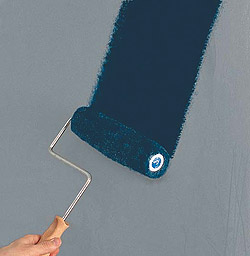
Primers and Topcoats,
Saving Time & Money
Match Them Up for Best Results. Choosing the right primer saves time and money — and makes your job a whole lot easier.
by Susan Brimo-Cox
Special problems crop up when your topcoat is a deep or rich color, like red. Over a white primer it is difficult to achieve the desired color with minimal topcoats.
Cindy Mansfield, brand manager for Devoe Paint at ICI Paint, likens these colors to working with cellophane. “The colorants are translucent themselves, so it’s like putting on colored cellophane. You’d have to put several layers on to get the real color.” Reds, yellows and oranges are especially translucent, she says.
Revnew has a similar view. While accent colors and bright bold shades contain pigments to achieve their color depth, he says, they have less titanium dioxide, an ingredient that helps give paint its opacity. “As a paint ingredient, pigments are more transparent than opaque, so bold accent colors that contain higher amounts of translucent pigments and lesser amounts of titanium dioxide tend to be somewhat transparent.”
The problem with using a white primer under a vivid topcoat has to do with light reflectance. Dark colors absorb light. Light colors reflect light.
Let’s use red as an example. A brilliant red topcoat will absorb light. But, because it is somewhat translucent, it allows the light to pass through. If the light hits a white primer underneath it will bounce back and produce visual inconsistencies in the topcoat color. You’d need multiple topcoats to build up enough hide to counteract this process.
 Case in point: Have you ever wound up with a darker band of color around the edges of a wall? Mansfield calls this “picture framing” and explains that that is because the coating applied with the brush (where you cut-in at the edges) is thicker than what you laid down in the center with the roller. The thicker coating doesn’t allow as much light to bounce back through. Case in point: Have you ever wound up with a darker band of color around the edges of a wall? Mansfield calls this “picture framing” and explains that that is because the coating applied with the brush (where you cut-in at the edges) is thicker than what you laid down in the center with the roller. The thicker coating doesn’t allow as much light to bounce back through.
One solution used by some contractors is to add colorant to tint a white primer. But there is only so much colorant you can add to a can of primer; usually only 2 to 4 ounces. Add too much and you can compromise the very characteristics you may have chosen a primer for: water resistance and adhesion, stain blocking, and corrosion-resistance, to name a few.
A couple of other options are also available when you’re working with strong colors.
Some paint manufacturers offer specialty primers — frequently called deep base primers — that are already tinted. “These products are excellent when approximating the topcoat color. The primer can be tinted usually to half the strength of the finish coat in order to achieve a darker color,” reports Tony Jager, commercial segment manager at PPG Industries Inc.
Another solution is gray primers. “It’s such a simple concept,” Henry says. “You scratch your head and say, ‘Wow! Why didn’t they do this before?’” The automotive industry has done it for years for cars.
Well, several paint manufacturers have now introduced gray primers to the architectural paint market. Each brand is a little different and offers varying degrees of gray, but they are designed to match up value-wise with stronger topcoat colors.
This allows less light to reflect off the primer and through the transparent pigments of the topcoat, Revnew explains. “Because more light is reflected from a white undercoat and, instead, is absorbed by the gray undercoat, the topcoat color maintains improved and more accurate color integrity, and is truer to the depth of color as indicated on its corresponding chip or swatch.”
Mansfield agrees. “With the gray primers, we’ve matched the gray with specific deep colors so the light-reflecting values match.” And that’s really the solution to the problem with rich colors, she says. If the primer has the same light reflecting value as the topcoat there will be no bounce back.
Problem solved.
So, the key to ensuring the best topcoat results is to use a good primer. And, in choosing a primer, look for a primer that meets your specific needs. It should be obvious by now that they are not all the same.
For example, says Stauffer, “the function of (bare) drywall primers (often called ‘PVA Wall Primer’) is to seal the surface and help with sheen and color uniformity. These primers do not generally exhibit the high adhesion, stain-blocking and corrosion resistance of some other type primers, such as those that are characterized as ‘stain blocking’ or ‘stain inhibitive’ or ‘corrosion inhibitive.’”
So, if all you need is a basic white primer, that’s great. But if you need a multi-purpose primer, use one. And if you need a specialty primer, it is in your best interest to choose one of those.
Now, getting back to that better combination theme I started with, there’s one more that’s always at the back of your mind as a painting contractor: time and money. It’s a combination where less is more. And that’s just what the right primer can mean for you. The right primer equates to fewer topcoats. Fewer topcoats mean less time. Less time means more money — as in profit. Now that’s food for thought.
For more information about primers, sealers and undercoats, see the March/April 2001 issue of PaintPRO.

|

